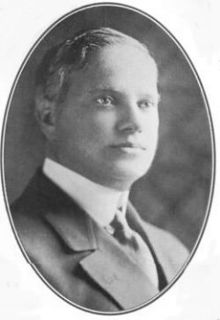Benjamin Guggenheim
Benjamin Guggenheim (born October 26, 1865 in Philadelphia , Pennsylvania , † April 15, 1912 in the North Atlantic when the Titanic sank ) was an American businessman . Benjamin Guggenheim was one of the richest men in the US and is still one of the most famous victims of the Titanic disaster. His person became the subject of many films and non-fiction books.
Life
Guggenheim was the sixth of eleven children of Meyer Guggenheim (1828–1905) and his wife Barbara Myers (1834–1900). The Jewish family originally came from Lengnau in Switzerland .
Benjamin Guggenheim married on October 24, 1894 Florette Seligman (1870–1937), the daughter of James Seligman, the president of a New York bank. They had three daughters: Benita Rosalind Guggenheim (* December 10, 1895 - July 21, 1927), Marguerite "Peggy" Guggenheim (* August 28, 1898 - December 23, 1979) and Barbara Hazel Guggenheim (1903-1995).
At the age of 20 his father sent him to Leadville , Colorado , to represent the interests of the family business in the mining sector . He recognized the great possibilities and on his advice the family got into the smelting business. The first smelter was built in Pueblo . As a result of their success, others were set up in Aguascalientes , Monterey and Perth Amboy , and from then on the family business concentrated on the smelting business. At the beginning of the 20th century, the Guggenheims controlled a large part of global copper production . In 1901 Benjamin Guggenheim went to Europe and returned in 1903. He set up a mining machinery factory in Milwaukee . In 1906 he became chairman of the board of the International Steam Pump Company , in which the family held large shares. In 1909 he became president of the company. The company operated seven plants in the United States and one in England, employing approximately 10,000 people. His fortune was estimated at US $ 380 million at the time.
Sinking of the Titanic
In April 1912 he was a passenger of the Titanic with his young French lover Léontine Aubart (1887–1964) and two employees . He lived in the luxury cabin B-84 (ticket no. 17593). His 1st class ticket is said to have cost £ 79 and 4 shillings, which would be around £ 6,800 in today's value (2019). When he had assigned his lover a place in a lifeboat and helped other passengers, he and his butler put on his best evening wear and said to a member of the crew: “We've dressed up in our best and are prepared to go down like gentlemen. ”( German : “ We are appropriately dressed and ready to go down like gentlemen ” .) This traditional statement made him more well known, as it was quoted very often, including in some films.
Benjamin Guggenheim did not survive the sinking of the Titanic . His body was never found. His widow Florette died on November 15, 1937 at the age of 67 in the Plaza Hotel in New York.
Benjamin Guggenheim in film and literature
In the later film adaptations of the shipwreck, Benjamin Guggenheim was portrayed by Camillo Guercio ( sinking of the Titanic , 1953), Harold Goldblatt ( the last night of the Titanic , 1958), John Moffatt ( SOS Titanic , 1979) and Michael Ensign ( Titanic , 1997).
Furthermore, Benjamin Guggenheim is treated in the following non-fiction books:
- John P. Eaton, Charles A. Hass: Titanic - Triumph und Tragödie , Heyne, Munich 1997, ISBN 3-45-312890-7
- Walter Lord: The Titanic Catastrophe , Heyne, Munich 2002, ISBN 3-45-305909-3
- Donald Lynch, Ken Marschall: Titanic - Queen of the Seas , Heyne, Munich 1997, ISBN 3-45-305930-1
Individual evidence
- ↑ Report in the New York Times of April 16, 1912
- ↑ encyclopedia-titanica
- ^ Mr Benjamin Guggenheim
- ↑ Calculation of inflation and price increase between two dates Great Britain
- ↑ From the copper king to the art corporation. In: 3sat.de
- ^ Benjamin Guggenheim ( Memento of January 2, 2008 in the Internet Archive ) Internet Movie Database
Web links
| personal data | |
|---|---|
| SURNAME | Guggenheim, Benjamin |
| BRIEF DESCRIPTION | American businessman |
| DATE OF BIRTH | October 26, 1865 |
| PLACE OF BIRTH | Philadelphia , Pennsylvania |
| DATE OF DEATH | April 15, 1912 |
| Place of death | North Atlantic when the Titanic sank |
